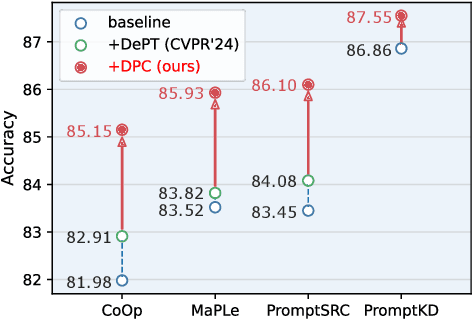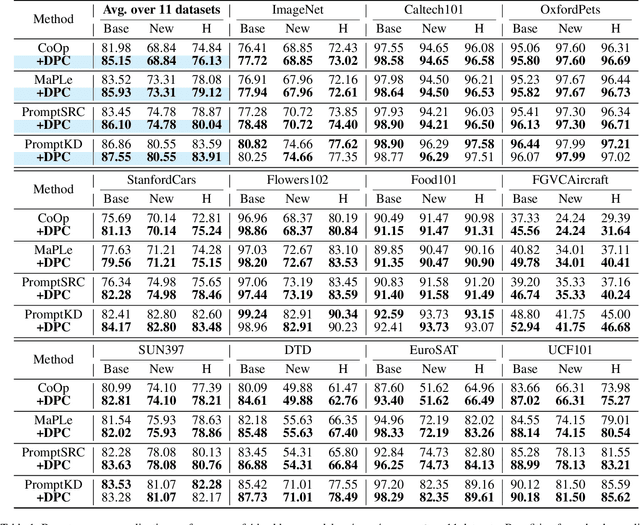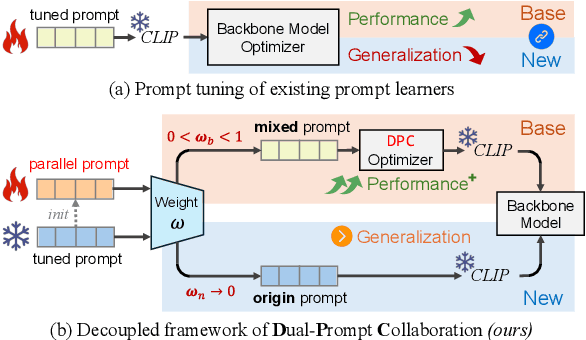Jing Jiang
Bi-level Personalization for Federated Foundation Models: A Task-vector Aggregation Approach
Sep 16, 2025Abstract:Federated foundation models represent a new paradigm to jointly fine-tune pre-trained foundation models across clients. It is still a challenge to fine-tune foundation models for a small group of new users or specialized scenarios, which typically involve limited data compared to the large-scale data used in pre-training. In this context, the trade-off between personalization and federation becomes more sensitive. To tackle these, we proposed a bi-level personalization framework for federated fine-tuning on foundation models. Specifically, we conduct personalized fine-tuning on the client-level using its private data, and then conduct a personalized aggregation on the server-level using similar users measured by client-specific task vectors. Given the personalization information gained from client-level fine-tuning, the server-level personalized aggregation can gain group-wise personalization information while mitigating the disturbance of irrelevant or interest-conflict clients with non-IID data. The effectiveness of the proposed algorithm has been demonstrated by extensive experimental analysis in benchmark datasets.
FeDaL: Federated Dataset Learning for Time Series Foundation Models
Aug 06, 2025Abstract:Dataset-wise heterogeneity introduces significant domain biases that fundamentally degrade generalization on Time Series Foundation Models (TSFMs), yet this challenge remains underexplored. This paper rethink the development of TSFMs using the paradigm of federated learning. We propose a novel Federated Dataset Learning (FeDaL) approach to tackle heterogeneous time series by learning dataset-agnostic temporal representations. Specifically, the distributed architecture of federated learning is a nature solution to decompose heterogeneous TS datasets into shared generalized knowledge and preserved personalized knowledge. Moreover, based on the TSFM architecture, FeDaL explicitly mitigates both local and global biases by adding two complementary mechanisms: Domain Bias Elimination (DBE) and Global Bias Elimination (GBE). FeDaL`s cross-dataset generalization has been extensively evaluated in real-world datasets spanning eight tasks, including both representation learning and downstream time series analysis, against 54 baselines. We further analyze federated scaling behavior, showing how data volume, client count, and join rate affect model performance under decentralization.
Learn to Preserve Personality: Federated Foundation Models in Recommendations
Jun 13, 2025Abstract:A core learning challenge for existed Foundation Models (FM) is striking the tradeoff between generalization with personalization, which is a dilemma that has been highlighted by various parameter-efficient adaptation techniques. Federated foundation models (FFM) provide a structural means to decouple shared knowledge from individual specific adaptations via decentralized processes. Recommendation systems offer a perfect testbed for FFMs, given their reliance on rich implicit feedback reflecting unique user characteristics. This position paper discusses a novel learning paradigm where FFMs not only harness their generalization capabilities but are specifically designed to preserve the integrity of user personality, illustrated thoroughly within the recommendation contexts. We envision future personal agents, powered by personalized adaptive FMs, guiding user decisions on content. Such an architecture promises a user centric, decentralized system where individuals maintain control over their personalized agents.
Effects of Theory of Mind and Prosocial Beliefs on Steering Human-Aligned Behaviors of LLMs in Ultimatum Games
May 30, 2025Abstract:Large Language Models (LLMs) have shown potential in simulating human behaviors and performing theory-of-mind (ToM) reasoning, a crucial skill for complex social interactions. In this study, we investigate the role of ToM reasoning in aligning agentic behaviors with human norms in negotiation tasks, using the ultimatum game as a controlled environment. We initialized LLM agents with different prosocial beliefs (including Greedy, Fair, and Selfless) and reasoning methods like chain-of-thought (CoT) and varying ToM levels, and examined their decision-making processes across diverse LLMs, including reasoning models like o3-mini and DeepSeek-R1 Distilled Qwen 32B. Results from 2,700 simulations indicated that ToM reasoning enhances behavior alignment, decision-making consistency, and negotiation outcomes. Consistent with previous findings, reasoning models exhibit limited capability compared to models with ToM reasoning, different roles of the game benefits with different orders of ToM reasoning. Our findings contribute to the understanding of ToM's role in enhancing human-AI interaction and cooperative decision-making. The code used for our experiments can be found at https://github.com/Stealth-py/UltimatumToM.
Federated Adapter on Foundation Models: An Out-Of-Distribution Approach
May 02, 2025Abstract:As foundation models gain prominence, Federated Foundation Models (FedFM) have emerged as a privacy-preserving approach to collaboratively fine-tune models in federated learning (FL) frameworks using distributed datasets across clients. A key challenge for FedFM, given the versatile nature of foundation models, is addressing out-of-distribution (OOD) generalization, where unseen tasks or clients may exhibit distribution shifts leading to suboptimal performance. Although numerous studies have explored OOD generalization in conventional FL, these methods are inadequate for FedFM due to the challenges posed by large parameter scales and increased data heterogeneity. To address these, we propose FedOA, which employs adapter-based parameter-efficient fine-tuning methods for efficacy and introduces personalized adapters with feature distance-based regularization to align distributions and guarantee OOD generalization for each client. Theoretically, we demonstrate that the conventional aggregated global model in FedFM inherently retains OOD generalization capabilities, and our proposed method enhances the personalized model's OOD generalization through regularization informed by the global model, with proven convergence under general non-convex settings. Empirically, the effectiveness of the proposed method is validated on benchmark datasets across various NLP tasks.
Toward Generalizable Evaluation in the LLM Era: A Survey Beyond Benchmarks
Apr 26, 2025Abstract:Large Language Models (LLMs) are advancing at an amazing speed and have become indispensable across academia, industry, and daily applications. To keep pace with the status quo, this survey probes the core challenges that the rise of LLMs poses for evaluation. We identify and analyze two pivotal transitions: (i) from task-specific to capability-based evaluation, which reorganizes benchmarks around core competencies such as knowledge, reasoning, instruction following, multi-modal understanding, and safety; and (ii) from manual to automated evaluation, encompassing dynamic dataset curation and "LLM-as-a-judge" scoring. Yet, even with these transitions, a crucial obstacle persists: the evaluation generalization issue. Bounded test sets cannot scale alongside models whose abilities grow seemingly without limit. We will dissect this issue, along with the core challenges of the above two transitions, from the perspectives of methods, datasets, evaluators, and metrics. Due to the fast evolving of this field, we will maintain a living GitHub repository (links are in each section) to crowd-source updates and corrections, and warmly invite contributors and collaborators.
WALL-E 2.0: World Alignment by NeuroSymbolic Learning improves World Model-based LLM Agents
Apr 22, 2025Abstract:Can we build accurate world models out of large language models (LLMs)? How can world models benefit LLM agents? The gap between the prior knowledge of LLMs and the specified environment's dynamics usually bottlenecks LLMs' performance as world models. To bridge the gap, we propose a training-free "world alignment" that learns an environment's symbolic knowledge complementary to LLMs. The symbolic knowledge covers action rules, knowledge graphs, and scene graphs, which are extracted by LLMs from exploration trajectories and encoded into executable codes to regulate LLM agents' policies. We further propose an RL-free, model-based agent "WALL-E 2.0" through the model-predictive control (MPC) framework. Unlike classical MPC requiring costly optimization on the fly, we adopt an LLM agent as an efficient look-ahead optimizer of future steps' actions by interacting with the neurosymbolic world model. While the LLM agent's strong heuristics make it an efficient planner in MPC, the quality of its planned actions is also secured by the accurate predictions of the aligned world model. They together considerably improve learning efficiency in a new environment. On open-world challenges in Mars (Minecraft like) and ALFWorld (embodied indoor environments), WALL-E 2.0 significantly outperforms existing methods, e.g., surpassing baselines in Mars by 16.1%-51.6% of success rate and by at least 61.7% in score. In ALFWorld, it achieves a new record 98% success rate after only 4 iterations.
FedMerge: Federated Personalization via Model Merging
Apr 09, 2025Abstract:One global model in federated learning (FL) might not be sufficient to serve many clients with non-IID tasks and distributions. While there has been advances in FL to train multiple global models for better personalization, they only provide limited choices to clients so local finetuning is still indispensable. In this paper, we propose a novel ``FedMerge'' approach that can create a personalized model per client by simply merging multiple global models with automatically optimized and customized weights. In FedMerge, a few global models can serve many non-IID clients, even without further local finetuning. We formulate this problem as a joint optimization of global models and the merging weights for each client. Unlike existing FL approaches where the server broadcasts one or multiple global models to all clients, the server only needs to send a customized, merged model to each client. Moreover, instead of periodically interrupting the local training and re-initializing it to a global model, the merged model aligns better with each client's task and data distribution, smoothening the local-global gap between consecutive rounds caused by client drift. We evaluate FedMerge on three different non-IID settings applied to different domains with diverse tasks and data types, in which FedMerge consistently outperforms existing FL approaches, including clustering-based and mixture-of-experts (MoE) based methods.
DPC: Dual-Prompt Collaboration for Tuning Vision-Language Models
Mar 17, 2025



Abstract:The Base-New Trade-off (BNT) problem universally exists during the optimization of CLIP-based prompt tuning, where continuous fine-tuning on base (target) classes leads to a simultaneous decrease of generalization ability on new (unseen) classes. Existing approaches attempt to regulate the prompt tuning process to balance BNT by appending constraints. However, imposed on the same target prompt, these constraints fail to fully avert the mutual exclusivity between the optimization directions for base and new. As a novel solution to this challenge, we propose the plug-and-play Dual-Prompt Collaboration (DPC) framework, the first that decoupling the optimization processes of base and new tasks at the prompt level. Specifically, we clone a learnable parallel prompt based on the backbone prompt, and introduce a variable Weighting-Decoupling framework to independently control the optimization directions of dual prompts specific to base or new tasks, thus avoiding the conflict in generalization. Meanwhile, we propose a Dynamic Hard Negative Optimizer, utilizing dual prompts to construct a more challenging optimization task on base classes for enhancement. For interpretability, we prove the feature channel invariance of the prompt vector during the optimization process, providing theoretical support for the Weighting-Decoupling of DPC. Extensive experiments on multiple backbones demonstrate that DPC can significantly improve base performance without introducing any external knowledge beyond the base classes, while maintaining generalization to new classes. Code is available at: https://github.com/JREion/DPC.
Consistent Client Simulation for Motivational Interviewing-based Counseling
Feb 05, 2025Abstract:Simulating human clients in mental health counseling is crucial for training and evaluating counselors (both human or simulated) in a scalable manner. Nevertheless, past research on client simulation did not focus on complex conversation tasks such as mental health counseling. In these tasks, the challenge is to ensure that the client's actions (i.e., interactions with the counselor) are consistent with with its stipulated profiles and negative behavior settings. In this paper, we propose a novel framework that supports consistent client simulation for mental health counseling. Our framework tracks the mental state of a simulated client, controls its state transitions, and generates for each state behaviors consistent with the client's motivation, beliefs, preferred plan to change, and receptivity. By varying the client profile and receptivity, we demonstrate that consistent simulated clients for different counseling scenarios can be effectively created. Both our automatic and expert evaluations on the generated counseling sessions also show that our client simulation method achieves higher consistency than previous methods.
 Add to Chrome
Add to Chrome Add to Firefox
Add to Firefox Add to Edge
Add to Edge